When teeth come into contact during chewing, they gradually wear down and form wear facets. Scientists have long been making use of small-scale wear traces left behind on these facets to reconstruct the diets and environments of living and extinct animals.
A team of researchers co-led by Dr. Ellen Schulz-Kornas and Dr. Kornelius Kupczik used 3D surface texture analysis to study the tooth surfaces of two wild chimpanzee populations from Western Africa. Dr. Schulz-Kornas explains: “Using high-resolution casts of teeth from museum collections, we investigated tooth surface modifications in order to trace seasonal dietary variations and individual feeding habits in these chimpanzees. This approach not only helped us uncover new details regarding the diet of our closest living primate relatives and their interactions with the environment, but if applied to human fossils it will also give us a glimpse into our own dietary heritage.”
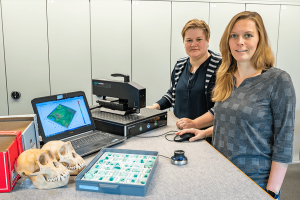
Above: Researchers Ellen Schulz-Kornas and Julia Stuhlträger at the lab.
Measuring microscopic tooth wear features
The analyses were performed using a confocal disc-scanning measurement system and data was processed with MountainsMap® Premium software. “In order to visualize and measure seasonally changing tooth wear surfaces (figure 1) we used a variety of pre-processing operators, like layer extraction, rotating, mirroring, leveling, spatial filtering and form removal (figure 2). By using a non-contact 3D confocal disc-scanning surface measuring system, we were able to investigate the surface topography within a single population at highest precision and resolution”, explains PhD student Julia Stuhlträger.
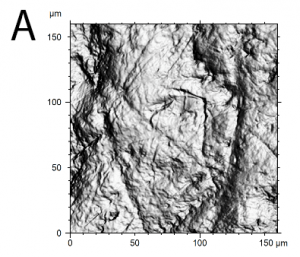
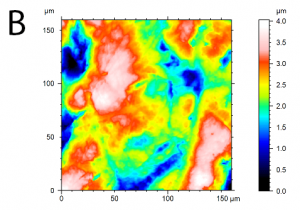
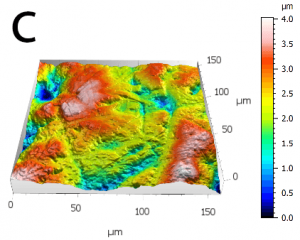
Figure 1. Three ways of visualizing a tooth wear surface of a chimpanzee cheek tooth: photo simulation of studied surface (A), pseudo-color map (B) and 3D-view (C).
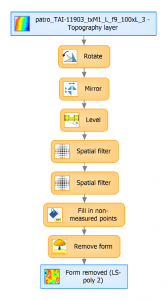
Figure 2. Template of processing workflow with the operators used on the surface.
The surface topography was expressed by height parameters (e.g. Sq, Sp, S5p, S5v), area (e.g. Sha, Sda) and volume (e.g. Vv, Vmp) according to ISO 25178, and flatness parameters (FLTv, FLTp) according to ISO 12781. Additionally, a motif (particle volume and height, figure 3A) and furrow analysis (furrow depth and density, figure 3B) were conducted. “Since the early days of ISO 25178 I have been fascinated by the possibility of using industrial standards on non-industrial surfaces. My team and I have applied this software to analyze very heterogeneous surface types in the fields of biology, anthropology, paleontology and, recently, dentistry. When the first draft of ISO 25178 became available in 2007, its standardized measuring routines advanced science and enhanced the functional understanding of tooth wear as a process tremendously,” says Schulz-Kornas.
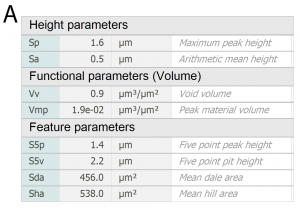
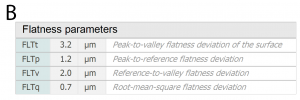
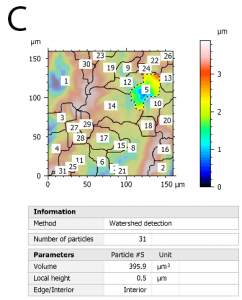
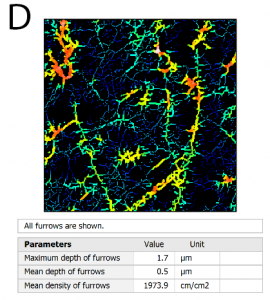
Figure 3. Selected calculated parameters according to ISO 25178 (A), ISO 12781 (B), motif (C), and furrow analysis (D) of the tooth wear surface of a chimpanzee.
Conclusion
Combining multi-scale approaches enabled the researchers to trace a single population’s dietary and environmental history. In this study, MountainsMap® software was used in fundamental research, specifically to characterize tooth wear patterns in living primates.
About the authors
- Ellen Schulz-Kornas (Max Planck Institute for Evolutionary Anthropology, Department of Human Evolution; University of Leipzig, Department of Cariology, Endodontology and Periodontology).
- Julia Stuhlträger (Max Planck Institute for Evolutionary Anthropology, Department of Human Evolution).
- Kornelius Kupczik (Max Planck Institute for Evolutionary Anthropology, Department of Human Evolution; Department of Anthropology, University of Chile; Microxchile SpA., Santiago de Chile, Chile).
Read more
Stuhlträger J, Schulz-Kornas E, Kullmer O, Janocha MM, Wittig RM, Kupczik K (2021) Dental wear patterns reveal dietary ecology and season of death in a historical chimpanzee population. PLoS ONE 16(5): e0251309. DOI: 10.1371/journal.pone.0251309
Schulz-Kornas E, Stuhlträger J, Clauss M, Wittig R, Kupczik K (2019) Dust affects chewing efficiency and tooth wear in forest dwelling Western chimpanzee (Pan troglodytes verus). American Journal of Physical Anthropology 169(1):66-77. DOI: 10.1002/ajpa.23808.
Instruments & software used
Non-contact 3D confocal disc-scanning surface measuring system + MountainsMap® Premium software.